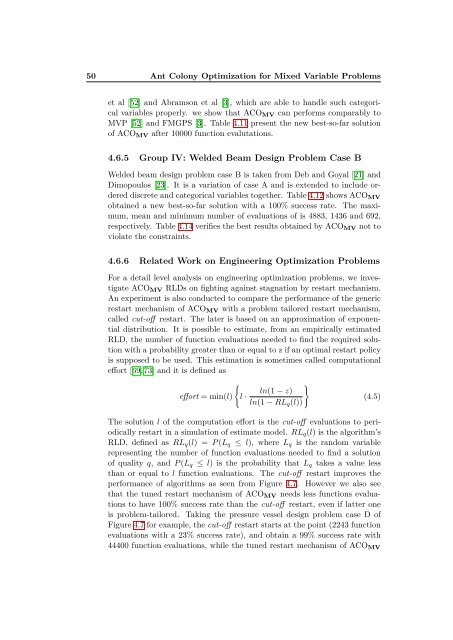Improved ant colony optimization algorithms for continuous ... - CoDE
Improved ant colony optimization algorithms for continuous ... - CoDE
Improved ant colony optimization algorithms for continuous ... - CoDE
Create successful ePaper yourself
Turn your PDF publications into a flip-book with our unique Google optimized e-Paper software.
50 Ant Colony Optimization <strong>for</strong> Mixed Variable Problems<br />
et al [52] and Abramson et al [3], which are able to handle such categorical<br />
variables properly. we show that ACOMV can per<strong>for</strong>ms comparably to<br />
MVP [52] and FMGPS [3]. Table 4.11 present the new best-so-far solution<br />
of ACOMV after 10000 function evalutations.<br />
4.6.5 Group IV: Welded Beam Design Problem Case B<br />
Welded beam design problem case B is taken from Deb and Goyal [21] and<br />
Dimopoulos [23]. It is a variation of case A and is extended to include ordered<br />
discrete and categorical variables together. Table 4.12 shows ACOMV<br />
obtained a new best-so-far solution with a 100% success rate. The maximum,<br />
mean and minimum number of evaluations of is 4883, 1436 and 692,<br />
respectively. Table 4.14 verifies the best results obtained by ACOMV not to<br />
violate the constraints.<br />
4.6.6 Related Work on Engineering Optimization Problems<br />
For a detail level analysis on engineering <strong>optimization</strong> problems, we investigate<br />
ACOMV RLDs on fighting against stagnation by restart mechanism.<br />
An experiment is also conducted to compare the per<strong>for</strong>mance of the generic<br />
restart mechanism of ACOMV with a problem tailored restart mechanism,<br />
called cut-off restart. The later is based on an approximation of exponential<br />
distribution. It is possible to estimate, from an empirically estimated<br />
RLD, the number of function evaluations needed to find the required solution<br />
with a probability greater than or equal to z if an optimal restart policy<br />
is supposed to be used. This estimation is sometimes called computational<br />
ef<strong>for</strong>t [69, 73] and it is defined as<br />
ef<strong>for</strong>t = min(l)<br />
<br />
l ·<br />
<br />
ln(1 − z)<br />
ln(1 − RLq(l))<br />
(4.5)<br />
The solution l of the computation ef<strong>for</strong>t is the cut-off evaluations to periodically<br />
restart in a simulation of estimate model. RLq(l) is the algorithm’s<br />
RLD, defined as RLq(l) = P (Lq ≤ l), where Lq is the random variable<br />
representing the number of function evaluations needed to find a solution<br />
of quality q, and P (Lq ≤ l) is the probability that Lq takes a value less<br />
than or equal to l function evaluations. The cut-off restart improves the<br />
per<strong>for</strong>mance of <strong>algorithms</strong> as seen from Figure 4.7. However we also see<br />
that the tuned restart mechanism of ACOMV needs less functions evaluations<br />
to have 100% success rate than the cut-off restart, even if latter one<br />
is problem-tailored. Taking the pressure vessel design problem case D of<br />
Figure 4.7 <strong>for</strong> example, the cut-off restart starts at the point (2243 function<br />
evaluations with a 23% success rate), and obtain a 99% success rate with<br />
44400 function evaluations, while the tuned restart mechanism of ACOMV

















